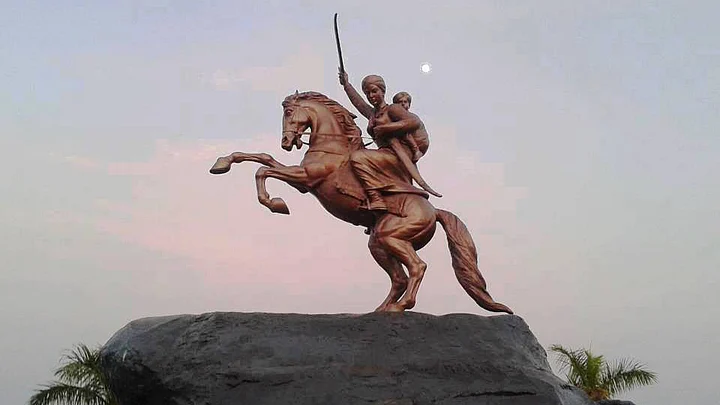(This article is being republished from The Quint’s archives to mark Rani Lakshmi Bai’s death annaiversary. It was originally published on 17 June 2015.)
Defeat in battles and consequent humiliations fuel nationalism as much as victories and triumphs of the past.
Having been a fugitive from British forces for three months, on 17 June 1858, Lakhshmibai, the Rani of Jhansi, made a desperate last stand against her English pursuers at Phoolbagh sector near Scindia’s imposing Gwalior fort.
She dashed into action and as she clashed with soldiers of the Eighth Hussars on the road between Kotah-ki-Sarai and Gwalior, she was struck and wounded by one of them. The wounds proved fatal. Her heroic struggle was at an end.
This single act of valour would be indelibly imprinted on the hearts and minds of Indians for generations, building in the process the legend of the warrior-queen: an unyielding woman who took on the British policy of the “doctrine of lapse” from the time Jhansi was eyed for a take-over in 1853.
Despite Uneasy Calm, No Stirrings of a Revolt
Lakshmibai (she was named Manikarnika after her birth in Benaras) and Gangadhar Rao, the raja of Jhansi, adopted Anand Rao (renamed Damodar Rao) in 1851 after their biological child passed away earlier that year.
When the raja died in 1853, the British refused to recognise Damodar Rao’s claims and applied the doctrine of lapse before annexing the small principality in Bundelkhand to its territories in May 1854. No resistance was offered against the annexation. She was accorded a pension of Rs 60,000 and was permitted to live in the palace besides being placed outside the jurisdiction of British courts and the police.
Her troops were dismissed and soldiers of the 12th Bengal Native Infantry Regiment were deployed to garrison the fort. She appealed twice to Governor-General Dalhousie who paid no attention to her entreaties.
However, “Everything went on peacefully and the new rulers saw no cause of anxiety,” wrote historian Surendra Nath Sen in 1857, which was published by the Indian government in observance of the centenary of the Indian mutiny.
The Rani Lent no Assistance to Mutineers
Indian and British historians alike have chronicled that when the mutiny broke in Meerut cantonment on 10 May, followed by the uprising in Delhi the next day,Company officials perceived no trouble among the sepoys in Jhansi.
In fact, Lakshmibai petitioned the Company’s political agent in Jhansi Captain Alexander Skene to raise troops that could protect her as well as English interests in the kingdom. She persisted with her appeals for a better deal for Damodar Rao even after mutinous disturbances broke out in Jhansi on 5 June 1857.
In her account of the mutiny to the commissioner WC Erskine, Lakshmibai complained that she paid large sums of money to the mutineers when they threatened to blowup her palace with guns. She deplored the June 8 massacre of several British men and women. Erskine, in his correspondence with Fort William, noted that the Rani had “in no way lent assistance to the mutineers.”
But as the contagion of the revolt spread across Bundelkhand, the British had begun to suspect – erroneously – Lakshmibai’s role in the massacre. At the same time, the expulsion of the British from Jhansi had given ideas to the surrounding Bundela chieftains who found this an opportune moment to invade Jhansi. Infact, in the course of the mutiny, the Rajput chiefs of Orchha and Datia attacked Jhansi.
It was while repulsing these attacks that Lakshmibai is said to have come in contact with some of the better known rebel leaders like Dhondu Panth (more famously known as Nana Sahib) and Tatiya Tope who seem to have played a significant role in turning her around. This is evident from the moment of Lakshmibai’s flight from Jhansi to Konch and Kalpi and finally to Gwalior where she was killed.
History’s Attempts to Glorify Rani Lakshmibai
Indian nationalists were “anxious to depict” Lakshmibai as one of the organisers of the revolt and “therefore heroine of the first war of independence.”
A section of British officialdom of the time expressed guilt but there were others in England who projected her as a “treacherous Jezebel.” There is no doubt that barring a few committed rebel leaders such as Ahmadullah and Tatiya Tope, amajority of men who led the insurgents did so for personal reasons. They rose against the British when their personal interests were affected.
As Sen wrote, “In spite of her best efforts to keep on friendly terms with the British she was driven by tortuous diplomacy to the other camp.” Which makes her an unwilling, even reluctant, rebel.
(At The Quint, we question everything. Play an active role in shaping our journalism by becoming a member today.)
